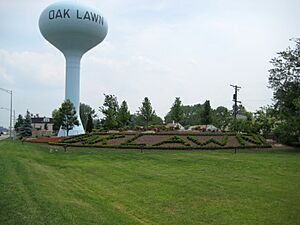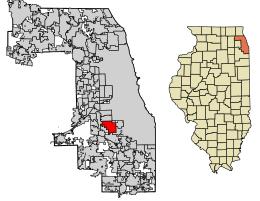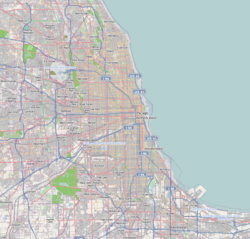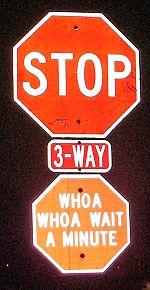Oak Lawn, Illinois facts for kids
Quick facts for kids
Oak Lawn, Illinois
|
|||
|---|---|---|---|
 |
|||
|
|||

Location of Oak Lawn in Cook County, Illinois
|
|||
| Country | |||
| State | |||
| County | Cook | ||
| Township | Worth | ||
| Incorporated | 1909 | ||
| Government | |||
| • Type | Council–manager | ||
| Area | |||
| • Total | 8.57 sq mi (22.20 km2) | ||
| • Land | 8.57 sq mi (22.20 km2) | ||
| • Water | 0.00 sq mi (0.00 km2) 0% | ||
| Population
(2020)
|
|||
| • Total | 58,362 | ||
| • Density | 6,809.24/sq mi (2,629.13/km2) | ||
| Standard of living (2009-11) | |||
| • Per capita income | $27,851 | ||
| • Median home value | $213,700 | ||
| ZIP code(s) |
60453, 60454, 60455, 60456, 60457, 60458, 60459
|
||
| Area code(s) | 708 | ||
| Geocode | 54820 | ||
| FIPS code | 17-54820 | ||
Oak Lawn is a village in Cook County, Illinois, USA. It is a suburb located southwest of Chicago. In 2020, about 58,362 people lived there.
Contents
History of Oak Lawn
How Oak Lawn Got Its Name
In the early 1800s, the area now known as Oak Lawn had a few different names. It was once called Black Oak Grove Road, then Black Oak, and even Agnes or Oak Park for a short time. Finally, in 1882, the post office, train station, and the community around them became known simply as Oak Lawn.
Early residents made money by selling farm and dairy products in Chicago. The area slowly grew with more homes and businesses.
Becoming a Village
In 1909, Oak Lawn officially became a village. After this, many improvements were made. The village got its first police and a village hall with a jail. Electric lights came to 95th Street in 1911. A volunteer fire department started in 1923, and Oak Lawn's first bank opened in 1925. A new high school district was also created.
By 1930, the population had grown to over 2,000 people. In 1934, a small collection of 100 books started the Oak Lawn Public Library. With help from the Works Progress Administration (WPA), a program created by President Franklin D. Roosevelt to help people find jobs during the Great Depression, a new library opened in 1936.
Growth and Challenges After 1945
After World War II, many soldiers came home and used the G.I. Bill to buy homes. This caused Oak Lawn's population to grow very quickly. From 1949, the village held an annual event called Oak Lawn Round-Up Days. This Western-themed celebration was very popular, attracting over 100,000 people in 1952! However, by 1957, it became too big to manage.
In the 1950s, a new library and fire station were built. By 1960, nearly 20,000 people lived in Oak Lawn.
The 1967 Tornado
On April 21, 1967, a powerful tornado hit Oak Lawn. It was one of the worst tornadoes to strike a city area. The tornado first touched down west of Oak Lawn, then moved through the village. It tossed cars and buses into the air. The tornado badly damaged Oak Lawn Community High School and other buildings.
In just 16 minutes, the storm left a path of destruction about 16 miles long. More than 30 people lost their lives.
Rebuilding and Modernization
After the tornado, the town was rebuilt. The population continued to grow, reaching its highest point between 1973 and 1976. Later, the number of residents decreased a bit, and some schools closed. To help the village grow again, leaders started a plan to redevelop the downtown area.
This plan focused on improving businesses and buildings around 95th Street between Cicero Avenue and Central Avenue.
Downtown Redevelopment
Starting in 2002, downtown Oak Lawn began a big redevelopment project. Many old buildings were taken down to make space for new, modern apartment buildings with shops on the ground floor. The Metra commuter train station was also expanded. It now includes a retail and office center, a new children's museum, and a large parking garage. Today, downtown Oak Lawn looks very different from how it did in 2002, with new high-rise buildings and shopping areas.
Geography of Oak Lawn
Oak Lawn covers an area of about 8.59 square miles (22.20 square kilometers). All of this area is land.
Population and People
| Historical population | |||
|---|---|---|---|
| Census | Pop. | %± | |
| 1910 | 287 | — | |
| 1920 | 489 | 70.4% | |
| 1930 | 2,045 | 318.2% | |
| 1940 | 3,483 | 70.3% | |
| 1950 | 8,751 | 151.2% | |
| 1960 | 27,471 | 213.9% | |
| 1970 | 60,305 | 119.5% | |
| 1980 | 60,590 | 0.5% | |
| 1990 | 56,182 | −7.3% | |
| 2000 | 55,245 | −1.7% | |
| 2010 | 56,690 | 2.6% | |
| 2020 | 58,362 | 2.9% | |
| U.S. Decennial Census 2010 2020 |
|||
According to the 2020 census, Oak Lawn had 58,362 residents. The population density was about 6,809 people per square mile.
The people living in Oak Lawn come from many different backgrounds. About 68% of residents were White, 7.6% African American, 2.8% Asian, and 0.8% Native American. About 22.5% of the population identified as Hispanic or Latino.
The average age of residents was 41 years old. About 21.7% of the population was under 18 years old.
Parks and Fun Activities
Oak Lawn has a large park system with over 300 acres of parks and recreational areas. These include:
- Playgrounds for kids
- Walking paths
- Baseball fields
- Basketball, volleyball, and tennis courts
- Outdoor swimming pools
- An indoor ice arena
- Two fitness centers
- An 18-hole golf course
There are 22 parks spread throughout Oak Lawn, so every area has its own place for fun and exercise.
Education in Oak Lawn
Oak Lawn has many schools for children of all ages.
Public Schools
- Elementary Schools (Kindergarten to 5th grade): Kolb, Lieb, Harnew, Columbus Manor, Covington, Hannum, Hometown, Kolmar, and Sward.
- Middle Schools: Simmons Middle School and Oak Lawn-Hometown Middle School.
- High Schools: Oak Lawn Community High School and Harold L. Richards High School.
Catholic Schools
The Roman Catholic Archdiocese of Chicago operates several Catholic grammar schools in Oak Lawn, including St. Germaine, St. Catherine, St. Linus, and St. Gerald.
Transportation and Infrastructure
Oak Lawn has a commuter train station on Metra's SouthWest Service line. This train provides service to downtown Chicago. There are also connections to Pace bus routes, which run along the village borders.
The Stop Sign Program
In 2007, Oak Lawn tried something new with its stop signs. They added extra messages to the signs to encourage drivers to stop. The village President, Dave Heilmann, came up with the idea, and residents could even suggest their own messages.
These signs got a lot of attention, but they didn't really make the roads safer. Some people found them funny, but many others thought it was a waste of taxpayer money. The Federal Highway Administration (FHWA) and IDOT (Illinois Department of Transportation) were concerned because the signs didn't follow standard rules. In April 2008, the village had to remove them after IDOT threatened to stop funding for local road projects.
Famous People from Oak Lawn
Many talented people have connections to Oak Lawn, including:
- Diandra Asbaty (born 1980), a professional bowler.
- Brian Bogusevic (born 1984), a former baseball player for the Chicago Cubs.
- Tim Byrdak (born 1973), a former Major League Baseball pitcher.
- Kevin Cronin (born 1951), the lead singer for the rock band REO Speedwagon.
- David Diehl (born 1980), a football player who won two Super Bowls with the New York Giants.
- Dan Donegan, the guitarist for the rock band Disturbed.
- Michael Flatley (born 1958), a famous Irish step dancer.
- C.J. Kupec, a basketball player who played for the Los Angeles Lakers.
- Rob Mackowiak, a former player for several Major League Baseball teams.
- Dwyane Wade, a former NBA player and three-time NBA champion with the Miami Heat, who attended Richards High School in Oak Lawn.
- Kanye West, a famous musician and rapper.
- Juice WRLD, a rapper who passed away in Oak Lawn in 2019.
See also
 In Spanish: Oak Lawn (Illinois) para niños
In Spanish: Oak Lawn (Illinois) para niños









